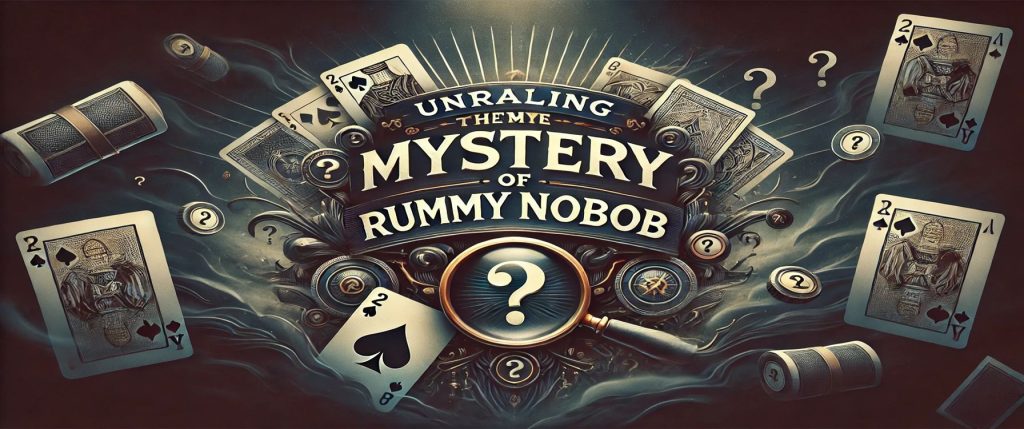Description

Rummy Nobob: A Complete Study Rummy Nobob is a fascinating card game that has gained popularity due to its unique combination of skill, strategy, & social interaction. It provides a distinctive take on classic rummy games, making it both approachable for novices and difficult for experienced players. It is frequently played in informal settings with friends and family.
Two to six players usually play the game, competing to outsmart their opponents while forming sets and runs from the cards they are dealt. Rummy Nobob’s appeal for parties & social gatherings stems from its capacity to promote competition and camaraderie. Fundamentally, the goal of Rummy Nobob is the experience that players have together, not just winning. The game creates a captivating environment that can last for hours by promoting strategic thinking, communication, and a little bit of luck. Players must continuously evaluate their hands while closely monitoring the moves of their opponents as they draw & discard cards. This dynamic interaction makes the game more complex & guarantees that no two sessions are ever the same.
Rummy Nobob never fails to enthrall players of all ages, whether it is played in a more competitive setting or in a more laid-back home setting. Rummy Nobob’s roots lie in the larger family of rummy games, which have been played for centuries. Although its exact origin is still unknown, it is generally accepted that Rummy Nobob developed from more conventional rummy variations that first appeared in the early 20th century.
The classic card games Gin Rummy and Indian Rummy, which have comparable mechanics but different rules and gameplay components, are probably where the game got its start. Rummy Nobob, a unique variation that blended aspects of several rummy styles, arose as players looked for new ways to enjoy these well-known formats. As the game expanded throughout the world, it changed to accommodate regional tastes & customs, resulting in differences in gameplay and rules. Because players can change the game to their preferences, this adaptability has helped it maintain its popularity over time. The fact that the name “Nobob” itself is believed to have originated from regional dialects or colloquial expressions highlights the game’s cultural relevance.
Over time, Rummy Nobob has established itself as a mainstay in many homes and is frequently handed down as a treasured family custom across generations. The goal of Rummy Nobob is to create legitimate combinations, or melds, using a standard 52-card deck. Both sets (three or four cards of the same rank) & runs (three or more consecutive cards of the same suit) can make up a meld. Each player is dealt a set number of cards at the start of the game; usually, this is seven or ten.
The remaining cards are then arranged in a draw pile. Players take turns selecting cards from the discard or draw piles in an effort to create better hands through melds. Until one player successfully places all of their cards in appropriate combinations, the game is over. The idea of “knocking,” which permits players to end a round when they feel they have formed enough melds, is one of the distinctive features of Rummy Nobob. A player discards one last card, lays down their melds, and reveals their hand when they knock. The remaining cards are then used by the other players to lay down any melds they can create.
The value of the unmelded cards that remain in the players’ hands is usually used to determine scoring, with lower scores being preferred. Because players must weigh the risk of accruing high-point cards against their desire to win, this scoring system introduces another level of strategy. Over the years, rummy nobob has become increasingly popular, especially in social settings where family & friends like to hang out. Its simplicity and accessibility make it appealing; even people who are not familiar with card games can pick up the fundamentals and begin playing right away.
For informal get-togethers, parties, and family reunions, this accessibility makes it the perfect option. Players are also kept interested by the game’s combination of strategy & luck because they have to modify their tactics frequently in response to the changing circumstances of each round. The popularity of Rummy Nobob has also increased due to the growth of online gaming platforms, which let users play the game while on the go or in the comfort of their own homes. These days, a lot of websites and mobile apps provide digital versions of the game with multiplayer features and tutorials. A wider audience has been exposed to Rummy Nobob thanks to its digital transformation, which has allowed players from various cultures to interact through this well-liked card game and transcend geographic boundaries.
Rummy Nobob keeps securing its position as one of the greatest card games ever as more people come to appreciate its allure. A combination of strategic thinking, astute observation, and flexibility are necessary to win at Rummy Nobob. Keeping a close eye on the cards that opponents are discarding is one useful tactic.
In order to better understand their opponents’ hands and modify their own tactics appropriately, players can keep track of which cards are regularly picked up or discarded. An opponent may not be attempting a run in that suit, for example, if they discard multiple hearts, which frees you up to concentrate on creating your own melds without worrying about being interrupted. A key component of Rummy Nobob strategy is skillfully controlling your own hand.
Holding onto versatile cards that can contribute to several possible melds will help players keep their options open. Holding onto a 7 and 8 of hearts, for instance, gives you the chance to form a set if another 7 is drawn later on or a run with 6-7-8. It’s also critical to know when to knock; if you knock too early, you risk receiving high-point cards that lower your score, and if you wait too long, your opponents may lay down their melds first.
Like many card games, Rummy Nobob has spawned a plethora of variations to suit a variety of tastes and playing styles. Changing the number of cards dealt at the start of each round is a common variation; for example, some groups might decide to deal just five cards rather than seven or ten. This change has the potential to drastically change the dynamics of the game, speeding up rounds and emphasizing quick decisions.
Also, some variations add an exciting twist to conventional strategies by introducing wild cards or jokers that can be used in place of any card in a meld. In “Rummy Nobob with Points,” an additional intriguing variation, players build up points over several rounds as opposed to competing for a single winner each time. In this format, players lose points for any unmelded cards they have left in hand at the end of each round and gain points based on the value of their melds. As players compete for overall victory over multiple rounds, this scoring system promotes a more competitive environment and pushes players to consider long-term strategies.
In many cultures, playing rummy nobob is more than just a recreational activity; it is a way for people to connect with one another and express their culture. A beloved custom that unites generations around the table is playing Rummy Nobob in many families. It offers a chance for sharing stories, giggling, and experiences that deepen family bonds.
Holidays and other special occasions frequently involve the game in family get-togethers, resulting in enduring memories that are handed down through the generations. Also, Rummy Nobob is a reflection of larger cultural ideals about cooperation and competition. Card games like Rummy Nobob are regarded as vital social activities that encourage communication between friends and family in many cultures where they are popular, like India or parts of Europe. They promote an atmosphere where players can benefit from each other’s strategies and experiences while simultaneously encouraging strategic thinking. Rummy Nobob thus represents cultural customs that prioritize interpersonal connections & community involvement, going beyond simple amusement.
By continuing to adjust to shifting societal trends and technological breakthroughs, Rummy Nobob seems to have a bright future. Increased accessibility and convenience have already revolutionized how people play card games thanks to the growth of online gaming platforms. Rummy Nobob’s online presence is expected to continue to expand as more people look to digital entertainment options, particularly through specialized apps and websites that provide interactive features and multiplayer options. Also, Rummy Nobob might become an even more varied game with new variations arising from various cultural influences as global connectivity grows thanks to social media and online communities.
While maintaining the essential elements of the game, players from different backgrounds may add distinctive rules or gameplay elements that enhance the overall experience. In the end, Rummy Nobob is positioned to endure as a popular card game that unites people from all walks of life for many years to come, whether it is played in person or online.
